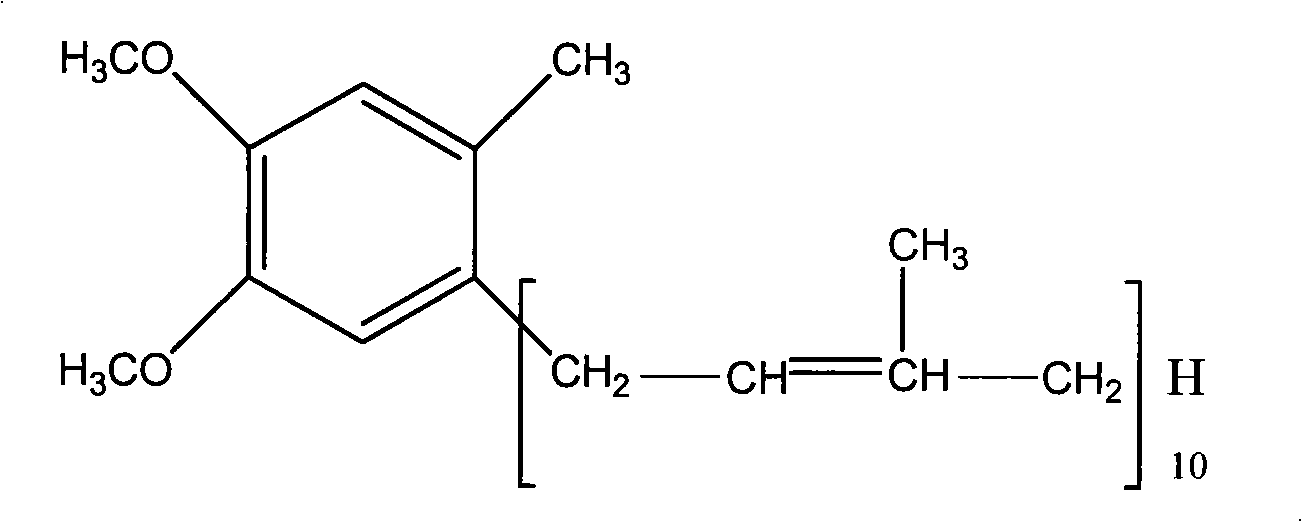Method for producing ubiquinone by using sticky red rhodotorula
A technology of Rhodotorula viscosum and yeast powder, which is applied in the field of microorganisms to achieve high potential effects
- Summary
- Abstract
- Description
- Claims
- Application Information
AI Technical Summary
Problems solved by technology
Method used
Image
Examples
Embodiment 1
[0034] Screening Coenzyme Q 10 High-yielding strain
[0035] The screened strains were purchased from the Institute of Microbiology, Chinese Academy of Sciences, with the number As2,102. For screening Coenzyme Q 10 For high-yielding strains, we adopt the method of activating Rhodotorula viscosus strains first, and after 36 hours of activation, mark lines on the plates that have been poured into the activation medium, pick out the single colonies with the best growth potential, and put them into the enrichment medium The liquid was cultured at 28°C for 36 hours, and then transferred to the solid medium of the enrichment medium for culture. Because the glucose content in this medium was relatively high, the colonies were plump in shape and relatively red in color. Then pick a single colony with the best growth and insert it into the harsh medium, and then insert it into the solid medium lacking nutrients for cultivation. Since the content of nutrients such as nitrogen source a...
Embodiment 2
[0058] Screening Coenzyme Q 10 High-yielding strain
[0059] The screened strains were purchased from the Institute of Microbiology, Chinese Academy of Sciences, and the number in the institute is As2,102. 10 For high-yield strains, the method we adopt is to first activate the Rhodotorula viscosus strain, and after 40 hours of activation, draw lines on the plates that have been poured into the activation medium, pick out the single colonies with the best growth, and put them into the enrichment medium The liquid was cultured at 32°C for 40 hours, and then transferred to the solid culture medium of the enrichment medium. Since the glucose content in this medium was relatively high, the colonies were plump in shape and relatively red in color. Then pick a single colony with the best growth and insert it into the harsh medium, and then insert it into the solid medium lacking nutrients for cultivation. Since the content of nutrients such as nitrogen source and carbon source in th...
Embodiment 3
[0082] Screening Coenzyme Q 10 High-yielding strain
[0083] The screened strains were purchased from the Institute of Microbiology, Chinese Academy of Sciences, and the number in the institute is As2,102. 10 For high-yield strains, the method we adopt is to activate the Rhodotorula viscosus strain first, and after 32 hours of activation, mark the plates on the plates that have been poured into the activation medium, select the single colonies with the best growth, and put them into the enrichment medium The liquid was cultured at 28°C for 32 hours, and then transferred to the solid culture medium of the enrichment medium for culture. Because the glucose content in this medium is relatively high, the colony shape is plump and the color is relatively red. Then pick a single colony with the best growth and insert it into the harsh medium, and then insert it into the solid medium lacking nutrients for cultivation. Since the content of nutrients such as nitrogen source and carbon...
PUM
 Login to View More
Login to View More Abstract
Description
Claims
Application Information
 Login to View More
Login to View More - R&D
- Intellectual Property
- Life Sciences
- Materials
- Tech Scout
- Unparalleled Data Quality
- Higher Quality Content
- 60% Fewer Hallucinations
Browse by: Latest US Patents, China's latest patents, Technical Efficacy Thesaurus, Application Domain, Technology Topic, Popular Technical Reports.
© 2025 PatSnap. All rights reserved.Legal|Privacy policy|Modern Slavery Act Transparency Statement|Sitemap|About US| Contact US: help@patsnap.com

